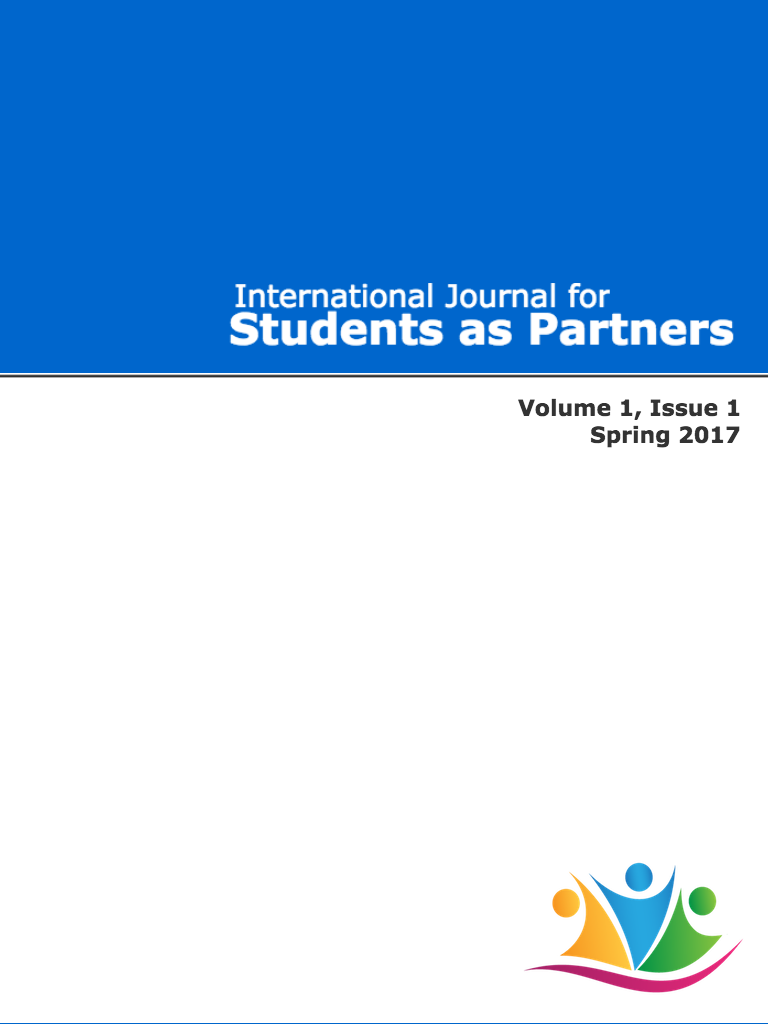A Framework to Explore Roles Within Student-Staff Partnerships in Higher Education: Which Students Are Partners, When, and in What Ways?
DOI :
https://doi.org/10.15173/ijsap.v1i1.3062Mots-clés :
partnership, participation, stakeholdersTéléchargements
Références
Bovill, C. (2017). Whole cohort co-creation of learning and teaching in higher education: Enhancing the relationship between teacher and students. Manuscript in preparation.
Bovill, C. (2014). An investigation of co-created curricula within higher education in the UK, Ireland and the USA. Innovations in Education and Teaching International, 51(1), 15-25.
Bovill, C., & Bulley, C. J. (2011). A model of active student participation in curriculum design: Exploring desirability and possibility. In Rust, C. Improving Student Learning (18) Global theories and local practices: institutional, disciplinary and cultural variations. Oxford: The Oxford Centre for Staff and Educational Development (pp. 176-188). Proceedings of the 2010 18th International Symposium/ISSOTL Conference, 19-22 October, Liverpool.
Bovill, C., Cook-Sather, A., Felten, P., Millard, L., & Moore-Cherry, N. (2016). Addressing potential challenges in co-creating learning and teaching: Overcoming resistance, navigating institutional norms and ensuring inclusivity in student-staff partnerships. Higher Education, 71(2), 195-208.
Bovill, C., Morss, K., & Bulley, C. (2009). Should students participate in curriculum design? Discussion arising from a first year curriculum design project and a literature review. Pedagogical Research in Maximising Education, 3(2), 17-26.
Bryson, C., Furlonger, R., & Rinaldo-Langridge, F. (2015, July). A critical consideration of, and research agenda for, the approach of “students as partners.” Paper presented at the International Conference on Improving University Teaching, Ljubljana, Slovenia.
Buckley, A. (2014). How radical is student engagement? (And what is it for?). Student Engagement and Experience Journal, 3(2). Retrieved from http://dx.doi.org/10.7190/seej.v3i2.95
Cook-Sather, A., & Agu, P. (2013). Students of color and faculty members working together toward culturally sustaining pedagogy. In J. E. Groccia & L. Cruz (Eds.), To improve the academy: Resources for faculty, instructional, and organizational development (Vol. 32, pp. 271–285). San Francisco: Jossey-Bass.
Cook-Sather, A., Bovill, C., & Felten, P. (2014). Engaging students as partners in learning and teaching: A guide for faculty. San Francisco: Jossey-Bass.
Deeley, S. (2014). Summative co-assessment: a deep learning approach to enhancing employability skills and attributes. Active Learning in Higher Education 15(1), 39-51.
Department for International Development. (2003). Tools for Development: A Handbook for those Engaged in Development Activity. Retrieved from http://www.lmgforhealth.org/node/103 .
Dunne, E. (2016). Design thinking: A framework for student engagement? A Personal view. Preface. Journal of Educational Innovation, Partnership and Change, 2(1). Retrieved from https://journals.gre.ac.uk/index.php/studentchangeagents/article/view/317
Healey, M., Flint, A., & Harrington, K. (2014). Students as partners in learning and teaching in higher education. York: Higher Education Academy. Retrieved from
Heron, J. (1992). The politics of facilitation: Balancing facilitator authority and learner autonomy. In J. Mulligan & C. Griffin (Eds.), Empowerment through experiential learning: Explorations of good practice (pp. 66–75). London: Kogan Page.
Könings, K.D., Bovill, C., & Woolner, P. (in press). Towards an Interdisciplinary Model of Practice for Participatory Building Design. European Journal of Education
Moore-Cherry, N., Healey, R., Nicholson, D.T., & Andrews, W. (2016) Inclusive partnership: Enhancing student engagement in geography. Journal of Geography in Higher Education, 40(1) 84-103.
REACT (n.d.). Realising Engagement Through Active Culture Transformation. Retrieved from http://www.studentengagement.ac.uk/index.php
Shor, I. (1992). Empowering education: Critical teaching for social change. London: University of Chicago Press
Téléchargements
Publié-e
Versions
- 2023-11-02 (2)
- 2017-05-08 (1)
Comment citer
Numéro
Rubrique
Licence
(c) Tous droits réservés Author 2017

Cette œuvre est sous licence Creative Commons Attribution 4.0 International.
Authors retain copyright and grant the journal right of first publication with the work simultaneously licensed under a Creative Commons Attribution License that allows others to share the work with an acknowledgement of the work's authorship and initial publication in this journal.
Authors are able to enter into separate, additional contractual arrangements for the non-exclusive distribution of the journal's published version of the work (e.g., post it to an institutional repository or publish it in a book), with an acknowledgement of its initial publication in this journal.
Authors are permitted to post their work online (e.g., in institutional repositories or on their website) prior to and during the submission process - this applies to the submitted, accepted, and published versions of the manuscript. This can lead to productive exchanges, as well as earlier and greater citation of published work (see The Effect of Open Access).


